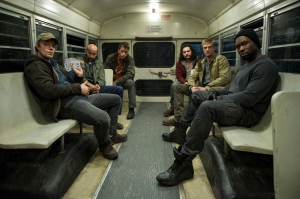Outlast Review
Story
“Outlast” casts you in the role of Miles Upshur, a reporter acting on a tip that something suspicious is happening at the Mount Massive Asylum. Miles sets out to break into the facility and discover what’s truly going on inside. This, of course, leads to Miles being trapped and hunted by crazed inmates and supernatural elements.
As fans of horror movies, this might seem like a familiar plot line. And it is. ”Outlast” won’t spin a narrative yarn that leaves you at the edge of your seat, it lets the gameplay handle that aspect. Instead it produces a fairly predictable tale that telegraphs it’s twists and turns long before they happen. Really, the story isn’t the key factor here, it’s how the story is told.
If this had been a movie, the story would be serviceable at best. However, as a video game, the story becomes a unique and immersive experience. As reporter Miles Upshur you’re trying to uncover the mysteries behind Mount Massive Asylum. This means searching the darkness for documents that reveal backstory for characters or events and it also means utilizing your camera to record and document things that are going on.
This makes the game immersive in a fun horror movie way. If you decide, as Miles, to say “Screw this, I just want to get out.” Then you can run through the game as fast as you can and ignore the underlying story in a mad scramble to escape. Or you could try piece things together and explore the asylum to it’s fullest, leading you into nerve wracking situations where you find yourself in a pitch black room struggling to find a way out before the batteries on your light die. It’s unearthing the story that makes this game interesting. Even if what you unearth isn’t all that amazing, getting it makes it worthwhile.
Ultimately, the story simply serves to get you in the perfect situations to have the crap scared out of you. And really, what’s wrong with that?
Gameplay
This is a first person survival-horror game distilled to it’s purest form. You’re just an average reporter with a camera. No weapons, no combat training, and no special powers. If you run into an enemy in the darkness, you can’t defend yourself. There are a few points where you have to frantically waggle your mouse to escape the clutches of an enemy, but most of the time your only hope is to run and hide.
Thankfully, Miles must have been on the track team back in high school because he’s got some speed on him. Unfortunately, this could also be a problem if you don’t pay attention to where you’re going. It’s easy to get lost and turned around when you’re trying to escape someone chasing after you. The game has fairly linear paths, but there are plenty of dead ends and side rooms to get you twisted around in the dark.
Not a lot of horror games are known for their smooth gameplay, but “Outlast” should be commended on creating a character with natural movement and grace. While Miles is running, you get a good sense of how fast he’s moving. The game also provides a system by which Miles can leap or duck under objects with relative ease. He even touches walls or leans on objects when you get too close to them, which is startling to see when you’re in first person mode. Suddenly there’s a disembodied hand touching the wall and you think “Oh crap, who’s that?!” Only to realize it’s your own hand.
It’s really not a surprise to see really well done traversal gameplay in “Outlast.” After all, the development team behind this game is comprised of guys who helped to make games like “Assassin’s Creed” and “Uncharted.”
There are a few instances where hiding is the best strategy, particularly when you’re running from a big behemoth with a penchant for ripping off heads. However, I found that in most situations I was able to lure an enemy into a big open room and then skirt around them quite easily. Encounters are still intense and can quickly lead a player to panic, but when you have the drop on an enemy the AI is easy to manipulate.
The coolest aspect of “Outlast”, though, is the use of the video camera. For some reason, Miles didn’t think to bring a flashlight into the Asylum, so you have to use the night vision on your camera to see in the dark. In turn, the camera runs on batteries that quickly drain when you use the night vision.
This creates scenarios where you might have to briefly conserve your batteries by turning off the night vision while you’re hiding in the dark. Let me tell you, those few seconds where you’re laying under a bed in the darkness and listening to the footsteps of your pursuer are the most intense seconds I’ve ever experienced in a game.
Also, I’ve never been so relieved in my life to see some fucking batteries. The game does an excellent job of dispensing them to you at appropriate intervals. I found myself always on the verge of nearly running out of them, only to find a couple lying around. It’s done in a way that keeps you in a constant state of anxiousness.
Even changing the batteries on your camera can rattle your nerves. If you’re in the dark when you need to change your batteries, Miles will put the camera down, change the batteries, and then turn it back on. This gives you a brief moment where your heart skips a beat in anticipation of something suddenly being in front of you. It’s a brilliant mechanic and device that the game uses in some pretty imaginative and fun ways.
I hate to mention it, but I’m sure this will be a point of contention for some people. The game is about four to six hours long. That may seem short, but keep in mind it’s only $20. I understand people want to get the most for their money, but I think that “Outlast” is worth every cent. While it isn’t long, it feels like it’s long enough. Some games have a problem where they overstay their welcome and continue past the point of being enjoyable. ”Outlast” is long enough to tell its tale and provides a perfectly replicated horror movie experience.
For a quick look at the game, be sure to watch our playthrough of it which you can see below.












